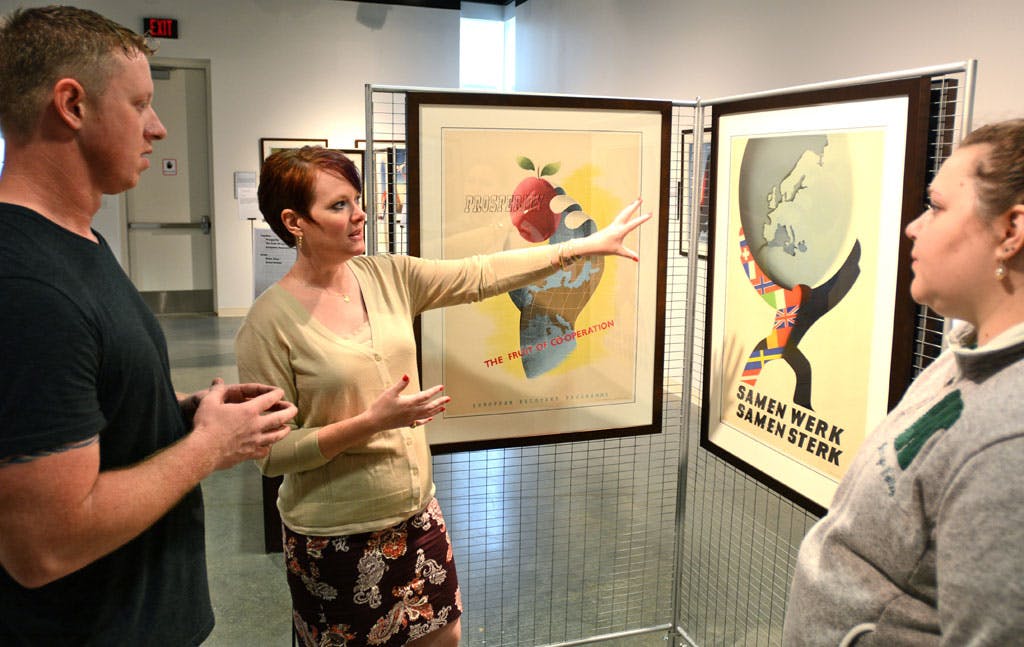Alumnus Sam Stratman '10 Donates Complete Set of Marshall Plan Posters to WC
The United States led the economic recovery of a devastated Europe in the years following World War II. That massive influx of American aid — $17 billion over four years — to a continent in crisis became known as the Marshall Plan.
(PICTURED) Quaker Heritage Center curator Ruth Brindle (CENTER) gives a sneak preview of the Marshall Plan posters exhibit to Rob Stuckert and Bekah Muchmore. The exhibit opening is June 5.
Colorful posters heralding a newly united Europe under U.S. leadership were plastered on buildings, walls and construction sites in 13 nations. The Meriam R. Hare Quaker Heritage Center (QHC) at Wilmington College will present an exhibit of those unique relics that combine propaganda and art June 5 through Dec. 8 in its gallery.
An opening reception is set for June 5 at 7 p.m. The QHC is located in the Boyd Cultural Arts Center, corner of College and Douglas streets, on Wilmington College’s campus. Summer gallery hours are Monday through Thursday, from 9 a.m. to 4 p.m., and Friday, from 9 a.m. to noon. Additional programming is planned during the exhibit’s run.
WC alumnus Sam Stratman donated the collection of 26 posters to Wilmington College. Stratman, a Wilmington native who worked for 25 years on Capitol Hill and served as Rep. Henry Hyde’s (R-Ill.) longtime press secretary, is teaching courses on Political Leadership and Agricultural Policy at the College. Also, a donor who wishes to remain unnamed provided funds to have the posters framed.
QHC curator Ruth Brindle said she has been looking forward to presenting this exhibit since Stratman made his gift of the collection several years ago.
“These posters lend themselves to the political, military and diplomatic history of the post-War and early Cold War periods,” she said, “and they’re artistic in their graphic design, colors and symbolism.”
The posters incorporate the themes of Europe and America working together and cooperating with one another. They were designed to remind the citizens of France, Denmark, Belgium, Great Britain and the other nine nations that the United States helped defeat the Axis powers and was playing a leading role in their recovery from economic, social and political turmoil.
Incredibly, in 1949-50, a whopping one-third of the United States’ federal budget was earmarked for the European Recovery Program, which became known as the Marshall Plan. While the U.S. wished to see those nations recover, it also had the ulterior motive of isolating Communism and making certain Western Europe didn’t fall under Soviet influence as the Cold War quickly heated up.
The Marshall Plan proved a phenomenal success in both aspects, as those nations to this day remain American allies as part of NATO (North Atlantic Treaty Organization) and Western Europe quickly rebounded. By the end of the Marshall Plan’s four-year run, the GDP of those nations increased by 33 percent, industrial production rose by more than 35 percent and agricultural production exceeded pre-war levels.
The posters resulted from a competition held in the 13 participating nations and, of the nearly 10,000 designs submitted, 25 that best captured the spirit of European reconstruction were selected.
A fascinating caveat to the story of the posters is there are actually 26 posters, although one quickly was kept out of sight (however, it is part of this exhibit). It features an image of two strong arms clasped in a handshake and surrounded by a dozen flags, including the United States, Great Britain, France, West Germany — and the USSR!
Yes, in the original Marshall Plan proposal, the Soviet Union and two of its Eastern Bloc states, Poland and Czechoslovakia, were offered reconstruction funds. According to Dr. Vinton Prince, emeritus professor of history at WC, “Stalin refused to accept it and kept his puppets from doing so as well.
“That may have saved the Marshall Plan,” he added. “As the Cold War heated up, Congress wouldn’t have funded it very long if the Communists were receiving aid too.”

Art Meets Propaganda with Marshall Plan Posters in New QHC Exhibit
Quaker Heritage Center